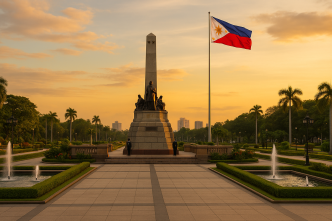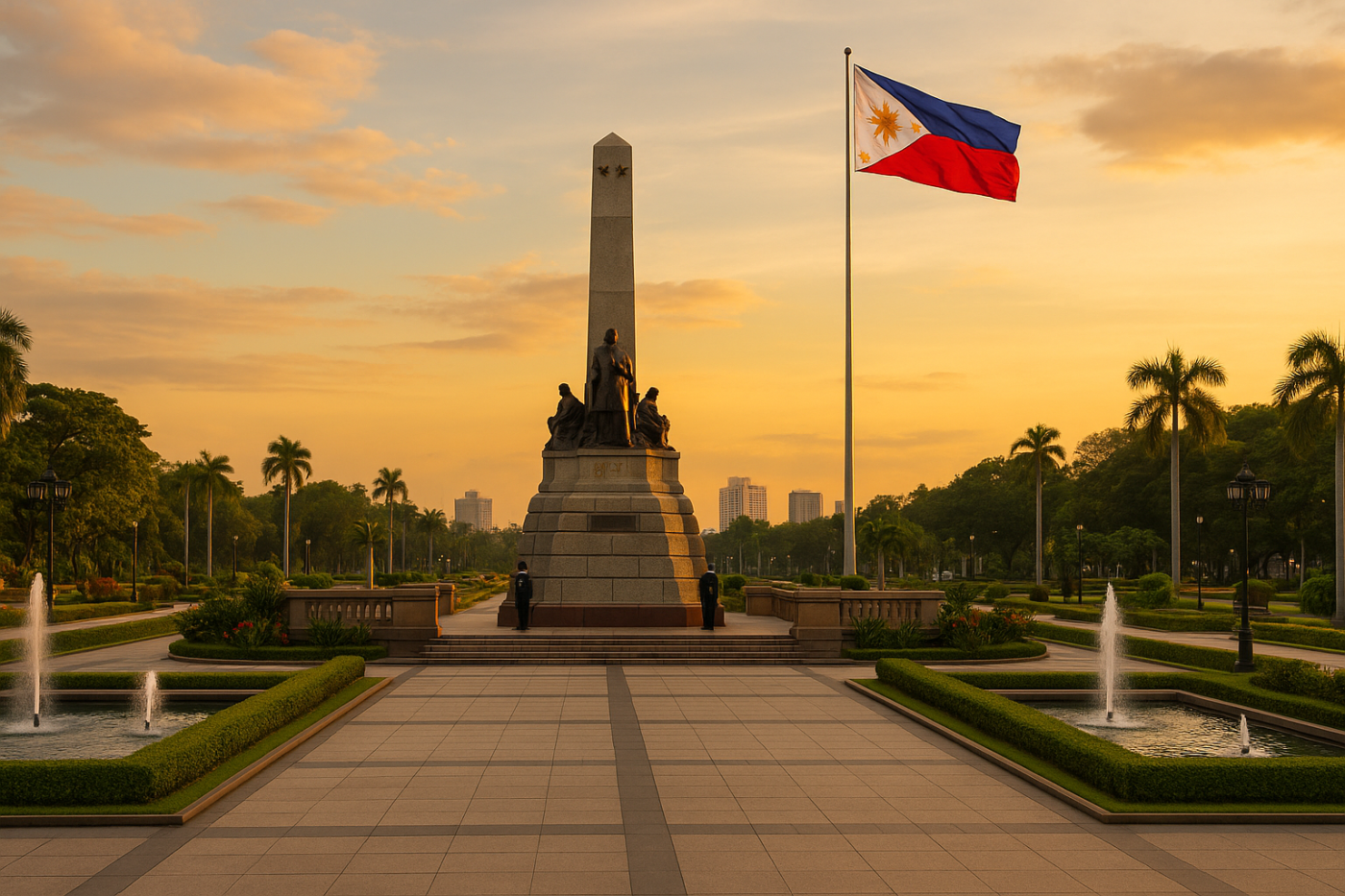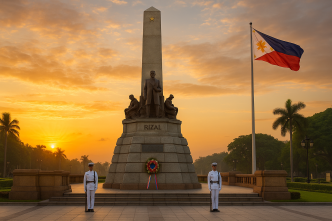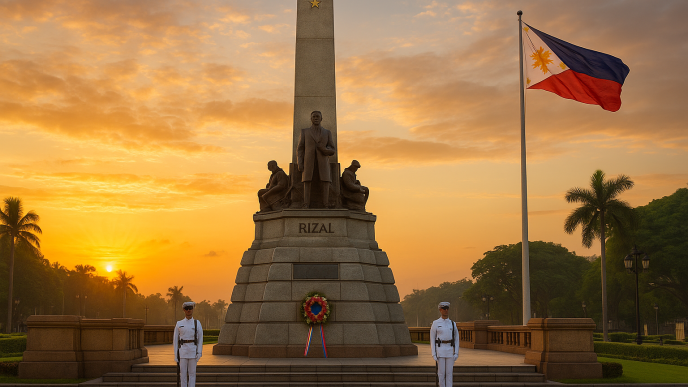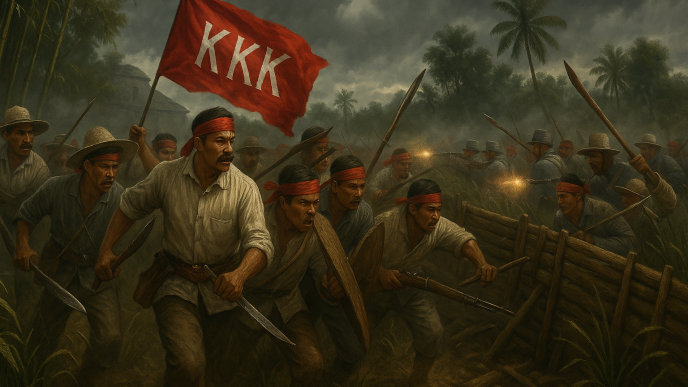Rizal Park (also known by its older name, Luneta) is Manila’s historic front lawn: a 58-hectare ensemble of lawns, lagoons, memorials, and museums at the edge of Manila Bay, just outside Intramuros.
Its layers run deep: a Spanish-era promenade, a colonial-era civic mall, a shrine and tomb for Jose Rizal, and today, a national commons where the country gathers for rites of memory and state.
From Bagumbayan to Luneta
The site was once Bagumbayan, a settlement cleared to protect the walls of Manila. West of the field, the Spanish laid out the Paseo de la Luneta in the early 1800s — a social promenade named after a crescent-shaped outwork (“lunette”) of the city’s defenses, not the plaza’s form. Evening band concerts and carriage drives made it the place to see and be seen.
Bagumbayan was also a place of execution. The martyred priests GomBurZa were put to death here in 1872; Jose Rizal was executed nearby on December 30, 1896. These deaths would give the ground its later commemorative power.
Why this exact site honors Rizal
In the American period, the new colonial government formalized national commemoration at Luneta. On September 28, 1901, the Philippine Commission passed Act No. 243, reserving public land upon the Luneta specifically to erect a Rizal monument that would also house his remains and creating a fund-raising committee that notably included Paciano Rizal.
An international design contest followed. Although the Italian sculptor Carlo Nicoli won first prize, the contract went to the second-placer, Swiss sculptor Richard Kissling, for his design Motto Stella (“Guiding Star”). Rizal’s remains—exhumed from Paco Cemetery in 1898 and kept by his family in Binondo—were solemnly transferred to the base of the monument on December 30, 1912. The shrine was unveiled a year later, on December 30, 1913.
A civic green in Burnham’s Manila
City planner Daniel Burnham envisioned the Luneta–Bagumbayan area as a national government center framed by neoclassical buildings — an echo of Washington, D.C.’s National Mall. While the full scheme was never completed, the idea fixed Luneta’s role as the city’s ceremonial open space.
Becoming a national park and who manages it
By Proclamation No. 234 (December 19, 1955), the Luneta lands were reserved as a national park. In the 1960s, the government created what is now the National Parks Development Committee (NPDC) to develop and manage Luneta (and Paco Park). In the late 1960s, the park was officially renamed Rizal Park.
Landmarks that make Luneta “Rizal Park”
- Rizal Monument and Tomb. Kissling’s bronze figure and granite obelisk mark Rizal’s resting place. The monument is guarded by the Philippine Marine Corps’ Marine Security and Escort Group, whose changing-of-the-guard has become a daily ritual.
- Exact execution site. About 100 meters northwest of the monument, a life-size sculptural tableau by Eduardo Castrillo marks the precise ground where Rizal fell, with an evening light-and-sound program dramatizing the final hour.
- Kilometer Zero. Executive Order No. 487 (1977) designated the Rizal Monument as KM 0 for Luzon — distances on national roads are reckoned from this point.
- Quirino Grandstand (formerly Independence Grandstand). Built for the July 4, 1946 independence ceremonies and rebuilt on the reclaimed shorefront in 1949, it has hosted inaugurations, papal Masses, and mass gatherings.
Gardens, artifacts, and additions
Rizal Park has grown as a campus of memory, art, and leisure: the Open-Air Auditorium (designed by National Artist Leandro Locsin) for free “Concert at the Park” performances; themed gardens; and lawns that double as festival grounds.
Two additions speak to global ties and layered heroism:
- The Heidelberg (Wilhelmsfeld) drinking fountain, used by Rizal during his 1886 stay in Germany, was donated to the Philippines in 1964 and installed at Luneta — today part of the Noli Me Tangere Garden.
- The “Sentinel of Freedom” (Lapu-Lapu Monument), a 12-meter bronze by Juan Sajid Imao, was unveiled in 2004 as a gift from the Korean Freedom League and has been re-erected as park redevelopment progressed in 2024.
A long-familiar feature — the giant relief map of the Philippines, created in the 1960s — was removed in 2023 amid plans for new exhibition facilities, a change that sparked lively public debate about heritage in the park.
What “being chosen” meant
That Luneta, of all places, would be the nation’s shrine to Rizal was not accidental. Act No. 243 fixed the site on the Luneta because the ground itself—Bagumbayan Field, the execution ground—was integral to the memory the state meant to honor. The act’s stipulation that the monument contain Rizal’s remains literally rooted the hero in the soil where he died, turning a colonial parade ground into a mausoleum and civic altar.
Subsequent planning (Burnham), park reservation (Proclamation 234), and dedicated management (NPDC) reinforced that choice, making Luneta both a place of mourning and a place of nation-making.
Today’s park: living traditions
Rizal Park remains the country’s most visited memorial landscape—home to wreath-layings by heads of state, citizenship rites, family picnics, and weekend concerts. The Marines’ silent watch at the monument, the grandstand’s state ceremonies, and the steady stream of schoolchildren to the execution site together keep the park’s double identity alive: a green refuge and the Republic’s symbolic plaza.
Fast facts
- Size: ~58 hectares (about 140 acres).
- Established as national park: 1955 (Proclamation No. 234).
- Rizal reinterred at the monument: Dec 30, 1912; monument unveiled: Dec 30, 1913.
- Kilometer Zero: In front of the Rizal Monument, by EO 487 (1977).
- Manager: National Parks Development Committee (NPDC), Department of Tourism.
